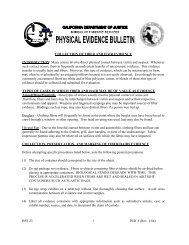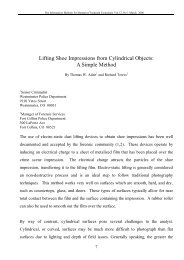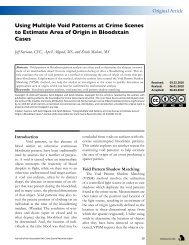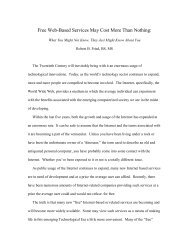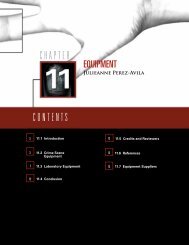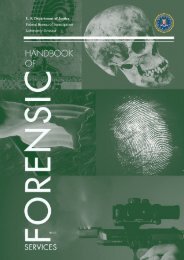PHYSICAL EVIDENCE MANUAL - Crime Scene Investigator Network
PHYSICAL EVIDENCE MANUAL - Crime Scene Investigator Network
PHYSICAL EVIDENCE MANUAL - Crime Scene Investigator Network
You also want an ePaper? Increase the reach of your titles
YUMPU automatically turns print PDFs into web optimized ePapers that Google loves.
Physical Evidence Manual<br />
Conduct a Detailed Search<br />
Conduct the search of the crime scene using one or more of the following<br />
systematic search approaches.<br />
• Spiral Search: When this crime scene search method is used, the analyst will<br />
start the search at a selected point at the edge of the scene. The analyst will<br />
walk in a circular pattern to the center of the scene, with the circle getting smaller<br />
as they go. This search method is effective in small areas.<br />
• Strip (Lane) Search: When this crime scene search method is used, the analyst<br />
will start the search at the southeast corner of the area to be searched. The<br />
analyst will walk north in a straight line, keeping parallel with the east edge until<br />
he/she reaches the north edge of the scene. At this time, he/she will take two<br />
(2) steps west and walk south in a line parallel to the first path until he reaches<br />
the south edge of the scene. This process is repeated until reaching the west<br />
edge of the scene. This search method works very well when there is a large<br />
area to be searched.<br />
• Zone or Grid Search: When this crime scene method is used, the analyst will<br />
divide the scene to be searched into quadrants. Additional personnel may be<br />
used for this method, or the analyst can perform the search independently. The<br />
personnel searching each quadrant will use any method that they choose. This<br />
method works well with large areas to be searched. In very large search sites<br />
the quadrant may be subdivided to effectively search the crime scene and make<br />
use of all personnel available to perform the search.<br />
• Wheel Search: When this crime scene search method is used, the analyst will<br />
begin the search in the middle of the scene. The analyst will pick out a landmark<br />
and walk in a direct line to it searching the area immediately in front of him/her.<br />
When the landmark has been reached then the analyst will turn and walk the<br />
same path to the originating point. Upon returning to the originating point they<br />
will choose another point of reference and repeat this search method until they<br />
have gone in a complete circle. For obvious reasons, this search method is<br />
effective in small areas.<br />
• Point to Point Search: When this crime scene search method is used, the<br />
analyst will go to the first piece of evidence, process it, then go to the next<br />
apparent piece of evidence, repeating this process until all evidence has been<br />
processed and collected. This search method works well in small or confined<br />
areas.<br />
• Logical Association: this method leads the investigator from one evidence item<br />
to another following a logical progression or evidence trail. Most used by<br />
investigators but requires patient thought, experience, and instinct. This method<br />
is frequently combined with one of the above listed search techniques.<br />
Adopted: May 2002<br />
Revisions: 6<br />
Last Revision: January 31, 2008<br />
8-5



